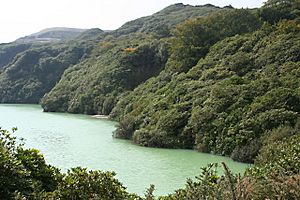St Austell Clay Pits facts for kids
| Site of Special Scientific Interest | |
| Area of Search | Cornwall |
|---|---|
| Coordinates | 50°23′37″N 4°49′12″W / 50.3935°N 4.8201°W |
| Interest | Biological |
| Area | 0.6 hectares (0.006 km2; 0.002 sq mi) |
| Notification | 2000 |
The St Austell Clay Pits are special places in Cornwall, England, UK. They are part of active china clay quarries. These areas are so important that they are called a Site of Special Scientific Interest (SSSI). They are also a Special Area of Conservation. This means they are protected because of their amazing plants and animals. One very rare plant, the western rustwort, grows here. It is found in only two other places in the whole UK!
What are the St Austell Clay Pits?
The St Austell Clay Pits SSSI covers about 0.6 hectares (which is like one and a half football fields). This special area was officially recognized in the year 2000. It is made up of three different spots, all located about 4 miles (6.4 km) north of the town of St Austell.
These spots are inside areas where people still dig for china clay. China clay is a type of clay used to make things like pottery and paper. The protected areas include the pits themselves, piles of leftover rock called spoil tips, and areas covered with plants growing on granite rocks. All these places together are also known as a Special Area of Conservation (SAC).
Why are the Clay Pits Important for Wildlife?
The St Austell Clay Pits are very important because of a rare plant called the western rustwort (Marsupella profunda). This plant is a type of liverwort, which is a small, simple plant like moss. In the UK, you can only find the western rustwort here and at two other sites in Cornwall. These other sites are Lower Bostraze and Leswidden SSSI and Tregonning Hill.
The western rustwort likes to grow in damp places. It often grows on clay or rocky waste material that is flat or gently sloped. It also likes soft or crumbly granite rocks.
Because this rare western rustwort lives here, an organization called Plantlife has named a large area around St Austell as an Important Plant Area. This area includes all the SSSI sites and many other places where mining used to happen or is still happening. Experts hope that these protected areas will help the western rustwort spread and grow in other parts of the china clay region.


